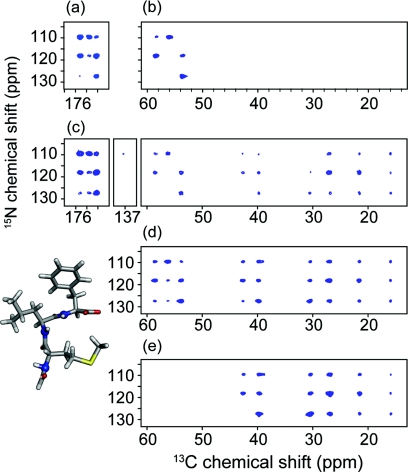Figure 7.
Figure illustrating the flexibility of PAIN-CP pulse sequence. Using an appropriate combination of rf strength, offset and mixing time PAIN-CP can accomplish: (a) selective N–C′ recoupling, (b) selective N–Cα recoupling, (c) broadband 15N–13C recoupling with contacts ranging from one-bond to long range, (d) band-selective 15N–13C recoupling to aliphatic carbons (with contacts ranging from one-bond to long range), (e) band-selective 15N–13C recoupling to aliphatic carbons except Cα's (with contacts ranging from two bond to long range). All spectra were obtained on NAc-[U-13C,15N]-f-MLF-OH at ω0H/2π = 750 MHz and ωr/2π = 20 kHz using eight scans per t1 point. Specific δp0 PAIN-CP settings were: (a) 8 ms mixing time with ω1C/N∕2π ∼15 kHz, ω1H∕2π ∼57 kHz with the 13C offset in the middle of C′ region, (b) 1 ms mixing time with ω1C/N∕2π ∼4 kHz, 1H 43 kHz with the 13C offset in the middle of the Cα region, (c) 3 ms mixing time with ω1C/N∕2π ∼53 kHz, ω1H∕2π ∼78 kHz with the 13C offset in the middle between C′ and Cα region, (d) 9 ms mixing time with ω1C/N∕2π ∼15 kHz, ω1H∕2π ∼time with ω1C/N∕2π ∼15 kHz, ω1H∕2π ∼57 kHz with the 13C offset at 28.8 ppm.

